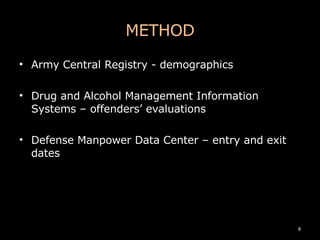Army and Child Maltreatment
- 1. Child Maltreatment and Substance Abuse Among U.S. Army Soldiers Authors: Deborah A. Gibbs, Sandra L. Martin, Ruby E. Johnson, E. Danielle Rentz, Monique Clinton-Sherrod, and Jennifer Hardison Reviewed by: Jasmine Joseph, Moncy Mathews & Rena Mehta 11/11/2008 Psych 308 UMBC
- 2. CHILD MALTREATMENT Federal law defines child maltreatment as: “ acts or failures to act that result in serious harm or imminent risk of serious harm, although states may enact lower thresholds for substantiation in their civil, criminal, or juvenile law.”
- 3. SUBSTANCE ABUSE AND CHILD MALTREATMENT Abuse of alcohol and other drugs has been linked to different forms of child maltreatment. Between one third and two thirds of cases involve offender substance abuse. Child maltreatment doubled or tripled in homes with substance-abusing parents.
- 4. QUESTION What type(s) of child maltreatment do you think is mostly associated with substance abuse? Least likely?
- 5. SUBSTANCE ABUSE AND CHILD MALTREATMENT Children, from substance abusing families, are more likely to be put in foster care. Offender substance abuse is related to severity and recurrence of maltreatment. Substance abuse is also correlated with intimate partner violence.
- 6. MILITARY Both substance abuse and child maltreatment occur in the military. Military members are more likely to report heavy alcohol use more than drugs. Lower rates of child maltreatment in military families compared to civilian families. However, disproportionally high rates of child abuse homicide and shaken baby syndrome.
- 7. OBJECTIVE To describe the extent of substance abuse among offenders within the military and to obtain information on the co-occurrence of child maltreatment and substance to help military service providers create prevention and treatment services.
- 8. METHOD Army Central Registry - demographics Drug and Alcohol Management Information Systems – offenders’ evaluations Defense Manpower Data Center – entry and exit dates
- 9. METHOD 5 year study - January 1, 2000 to December 31, 2004. 4,255 soldiers 296 soldiers (missing data) 3,959 soldiers (complete data) Offender was active duty soldier and a parent. Measure of substance abuse: based on report of first responder to the scene or assessment of clinical worker
- 11. RESULTS 13% of offenders used drugs or alcohol during their first child abuse incident. Alcohol (89%) Drugs (6%) Both (5%) Offenders who committed both spouse and child abuse in one day were more likely to have abused alcohol and drugs.
- 12. Characteristics of Offenders Offenders were more likely to be referred to substance abuse services Offenders’ abuse was not related to pay grade or age More Likely to be Less Likely to be Male Female Married Single White non-Hispanic Black and Hispanic
- 13. RESULTS 91% offenders did not have a recurring incident. Post-hoc: offenders exited the Army much quicker if the incident involved substance abuse. Substance abuse was less common when the incidents resulted in children being taken out of their homes.
- 14. DISCUSSION The intensity of substance abuse found in military populations is dramatically lower than in civilian populations. High degree of association between offender substance abuse at the time of incident and referrals to substance abuse services.
- 15. DISCUSSION Offenders in the military: more likely to commit child neglect less likely to commit physical abuse No correlation was found between substance abuse and recurrence of incidents.
- 16. DISCUSSION Strong correlation between child maltreatment and spouse abuse when substance abuse was involved. Partner violence strongly associated with alcohol abuse in both civilian and military populations.
- 17. DISCUSSION Analyses suggest that substance abuse assessments should be attentive to soldiers’ family and include referrals to family support services. Co-occurring substance, spouse, and child abuse mostly resulted in removal of offender from the abuse.
- 18. LIMITATIONS Since differences exist between the two populations, research cannot directly compare military and civilian populations. Incidents may be under, inconsistently, or over- reported. No mental health history

















